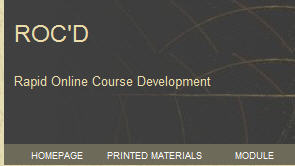MIT 500 – “ROC’D – Rapid Online Course Development”
 |
Context
The “ROC’D – Rapid Online Course Development” self-instructional module was completed as a partial requirement of the MIT 500: Instructional Systems Design: Theory and Research course. The project was supervised in the fall of 2008 by Dr. Mahnaz Moallem. The project consisted of project reports that outline the instructional design process from beginning (needs analysis) to end (evaluation) and a self-instructional module.
Conditions
This project was developed within a semester time frame; I worked collaboratively with one other MIT classmate, Kevin Wicker. The “ROC’D” project gave me an opportunity to practice my team work and communication skills. The self-instructional module was to serve as a three part simple tutorial on how to create an assignment, assessment, and electronic calendar within Blackboard.
Scope
Our project team utilized Richard Mayer’s “Designing Instruction for Constructivist Learning” (or SOI) model as the basis for the instructional strategies needed to design and develop the module. Also, Dick, Carey and Carey Systems Approach for Designing Instruction (2005) model was used as a framework to systematically analyze a performance problem and then design and develop the module as an instructional solution before conducting formative evaluation. The target audience for the self-instructional module were faculty members at UNCW. The module was designed to provide a learning solution to assist faculty with setting up their online courses using Blackboard. Three instructional videos were developed and then integrated in the module using Captivate. For formative evaluation, we first conducted one-on-one trials to evaluate the module. In addition to the learning module, three project reports were generated that included: an executive summary, needs assessment, instructional goals, theoretical rationale, learners' entry behaviors, performance context, performance objectives, assessment instruments, instructional strategies, results of one-on-one evaluation, and a planning and implementation log.
Role
I served as part of a two-person team with a fellow MIT student, to complete this project. As instructional designers, we conducted front-end analysis which included the needs assessment, learner, environmental and instructional goals analysis. Based on the results of the front-end analysis, learning goals, performance objectives, assessment items, and instructional strategies were designed and developed. During the development phase of this project, I constructed the web-based module using Captivate and Dreamweaver. I also created graphic organizers using Inspiration 7.
Reflection
I took this course after being in the program for one semester. The information that I gleaned from the course provided me with knowledge that bridged the gaps between my prior knowledge and new knowledge I was acquiring through the experience. If I were to go through analyzing, designing, developing and evaluating a module again, I would make notable changes in my design of the module. Also, I would select my delivery system differently. Not everyone has the internet, so publishing the module on a CD-ROM or DVD would have been more helpful. Lastly, I believe as a result of this project I learned how to be more effective in communicating with a project partner and identifying issues.